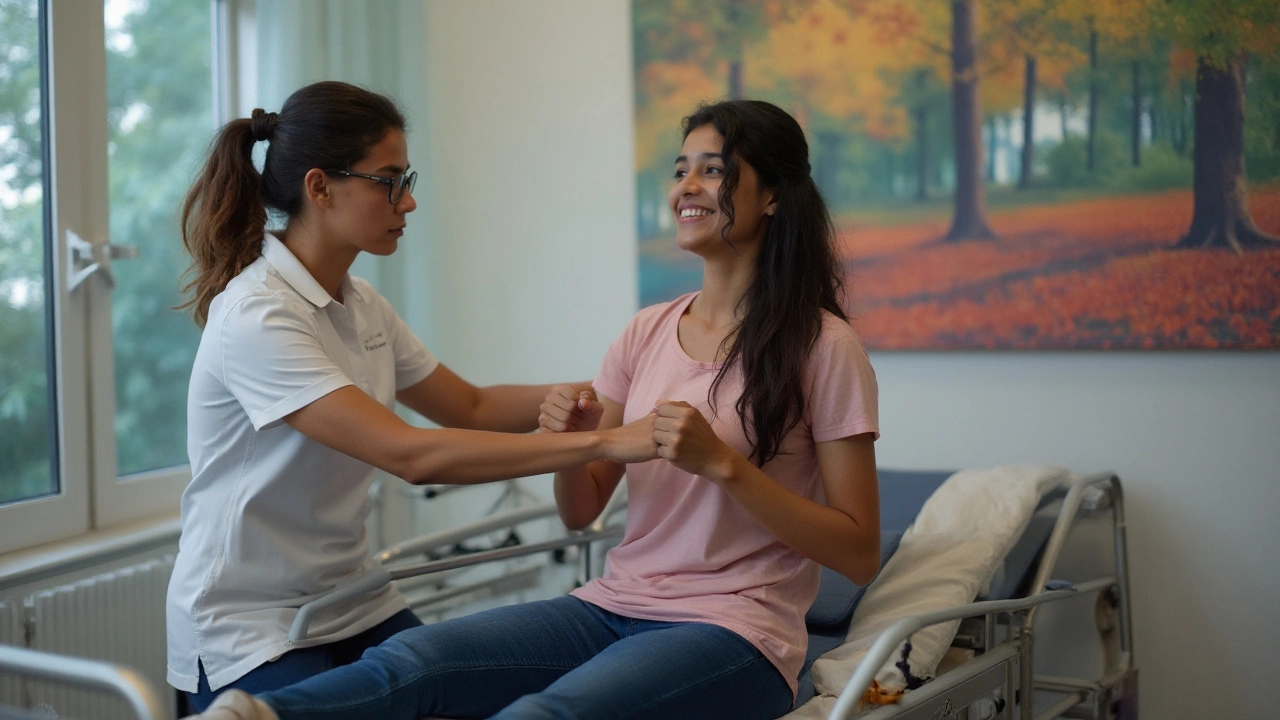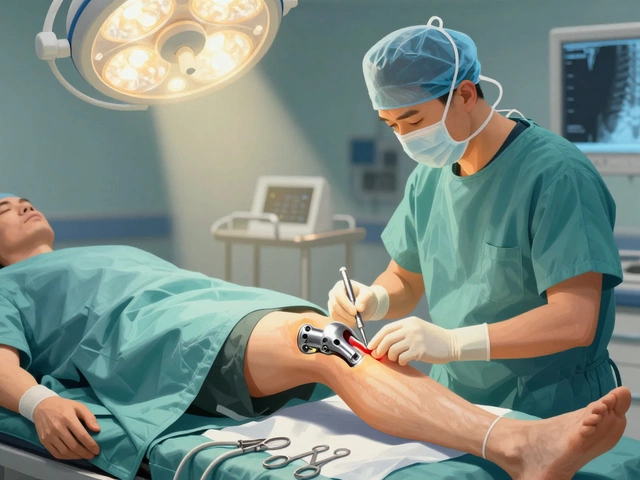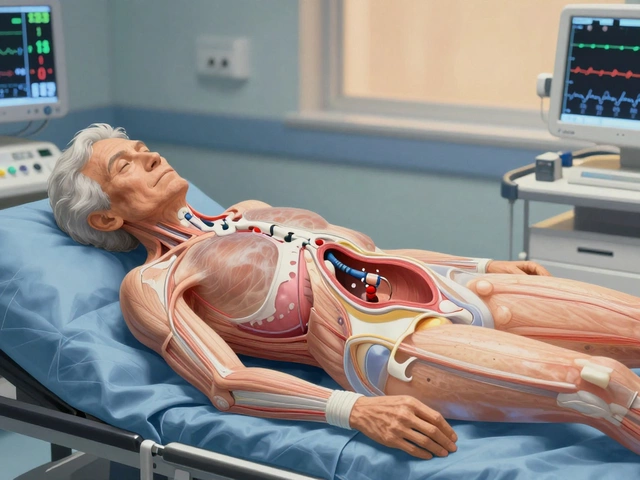Stepping into the world of orthopedic care might seem daunting, especially if you're grappling with pain or discomfort. But rest assured, the experience is structured to pinpoint the issue and propose an effective course of action.
At an orthopedic appointment, you'll first engage in a thorough conversation with your doctor. This involves discussing your medical history, current symptoms, and lifestyle factors that might influence your condition. From here, the process typically unfolds into diagnostic evaluations to get a clear picture of what's going on beneath the surface.
Be prepared for a range of treatment avenues, whether they lean towards conservative methods or more intensive interventions. Rehabilitation plays a key role on your road back to normalcy, with follow-up care being just as important to ensure long-lasting results.
Whether it's your first visit or a regular check-up, understanding what happens at an orthopedic clinic can demystify the process and help you take control of your health journey. Let’s delve into the details of how your visit can pave the way to better movement and overall well-being.
- The Initial Consultation
- Diagnostic Tests and Tools
- Treatment Options
- Rehabilitation and Recovery
- Follow-Up Care
- Tips for a Successful Orthopedic Visit
The Initial Consultation
When you walk into an orthopedic clinic, the initial consultation serves as the cornerstone of your entire orthopedic visit. It's an opportunity for both you and the orthopedic specialist to gain a better understanding of your medical needs and chart a course toward effective treatment. The consultation often begins with a thorough review of your medical history. Your doctor will be particularly interested in any past injuries, surgeries, or conditions that may inform your current ailment. It's important to be open and honest about any lifestyle factors, such as physical activity levels, that affect your orthopedic care. This comprehensive background check helps the specialist form a complete picture of your health.
Following the history review, you can expect a detailed discussion about your symptoms. You will need to describe the pain or discomfort you're experiencing, specifying where it occurs and its severity. Your specialist may ask questions like 'Does it get worse at specific times of the day?' or 'Have certain activities triggered or alleviated the pain?' By diving deep into these questions, the orthopedic professional can zero in on potential causes and rule out others. It's common for patients to feel anxious during this phase, but remember that open communication is your best tool for achieving a positive outcome.
The physical examination follows the discussion. Here, the orthopedic specialist will assess your range of motion, stability, and reflexes. Precision is key, as subtle differences in movement or symmetry can provide essential clues. Most orthopedic visits include this hands-on evaluation, which helps confirm suspicions the doctor might have gathered from your medical history and symptom talk. If the process seems a bit meticulous, rest assured it's a necessary step to ensure that no stone is left unturned.
Occasionally, the initial consultation ends with the recommendation for diagnostic tests to further clarify your condition. X-rays, MRIs, or CT scans might be ordered to provide a definitive look inside your body. These tests can reveal things like bone spurs, fractures, or soft tissue damage that may not be evident from an external exam. As noted by Dr. James Andrews, a notable orthopedic surgeon, "Effective diagnosis begins with a thorough consultation, but must be backed by diagnostic proof."
Many patients feel a sense of relief once this comprehensive initial consultation is complete. Not only does it serve to diagnose the issue, but it also sets the stage for orthopedic treatment. You're likely to leave with a clearer understanding of what's wrong and what the next steps might involve. Remember, the initial consultation is a chance to build a trusting relationship with your specialist. This episode is the first step in a journey towards recovery, armed with knowledge and empowered to tackle what lies ahead.
Diagnostic Tests and Tools
Navigating the world of orthopedic treatment often involves a blend of state-of-the-art diagnostic tests and tools designed to accurately assess bone and joint health. At the center of this journey is the goal to identify the root cause of discomfort or pain with precision. As you sit across from your orthopedic specialist, it isn't merely about naming the issue. It's about seeing it, understanding its extent, and crafting a tailored plan for your well-being.
A key first step in this process is often the X-ray, a common yet invaluable tool that provides a clear snapshot of bone structure. This enables doctors to pinpoint fractures, dislocations, and diseases like arthritis. Yet, not every problem is skin deep, making the MRI scan another pivotal player. Offering a more detailed image, this test reveals the soft tissues—ligaments, cartilage, and muscles—that live between those bones. The MRI helps detect ruptures, tears, or inflammation that might otherwise go unnoticed.
CT scans or computed tomography might also come into play, particularly when layered images are necessary to assess complex fractures or to plan surgical interventions. The resulting series of images deliver a 3D view of a particular area, aiding in diagnosis and treatment strategy alike. Sometimes, a hands-on approach with an ultrasound is needed, often in cases where moving images help in appraising conditions like tendon and joint disorders.
Blood tests might seem an unusual mention in orthopedic care, but they can reveal markers of inflammation or infection that would otherwise complicate a condition. Meanwhile, electromyography (EMG) studies measure the electrical activity of muscles, assisting in diagnosing issues like nerve compression or muscle diseases. Navigating the seemingly complex web of tests might feel daunting, yet every image drawn or strain recorded inch you closer to relief.
"Good diagnostics are the cornerstone of effective treatment," notes Dr. Jason Smith, a renown orthopedic surgeon with over two decades of experience under his belt. "They not only confirm what we suspect but often reveal what we had not even considered."
In summary, the use of these varied diagnostic techniques is vital in the world of orthopedics. Each test offers unique insights adding another piece to the puzzle that is human anatomy. Through these tests, insights into specific orthopedic issues are gathered, leading to more informed decisions and paving the way for effective orthopedic care.

Treatment Options
When you find yourself under the care of an orthopedic specialist, you are stepping into a world filled with a broad spectrum of orthopedic treatment options. These treatments are tailor-made considering the complexity of the human musculoskeletal system. Depending on the diagnosis, your orthopedic doctor may recommend anything from conservative management techniques to surgical interventions. Let’s uncover what these options typically include and how they cater specifically to supporting your body's intricate needs.
Conservative Management
Many conditions are first approached with non-surgical methods, also known as conservative management. This pathway is often effective for a range of situations, from minor injuries to more chronic issues. Physical therapy is a cornerstone of conservative management; it focuses on strengthening muscles, improving flexibility, and enhancing joint mobility. It is personalized to your condition and can significantly reduce pain. Alongside, medications might be prescribed. These could range from anti-inflammatory drugs to topical creams, to help manage pain and swelling. Assistive devices like braces or orthotic inserts could also be used to provide support and improve alignment.
Surgical Interventions
Sometimes, surgery becomes necessary, especially if a condition does not respond to non-invasive treatments. Orthopedic surgery spans from minimally invasive arthroscopic procedures to extensive reconstructive surgeries. Arthroscopy allows doctors to repair joint injuries using small incisions, which usually translates into quicker recovery periods. Joint replacement surgery, particularly for hips and knees, is another significant area where surgeons replace the damaged joint with a prosthesis. Despite its invasive nature, advances in technology have drastically improved outcomes, minimizing downtime and enhancing function post-recovery. Spinal surgeries, though more complex, offer relief from issues like herniated discs or scoliosis, restoring patients' mobility and quality of life.
"The most important factor in determining a patient's surgical treatment is their overall health status," says Dr. John Smith, an esteemed orthopedic surgeon. "When patients are a part of the decision-making process, outcomes are significantly better."
It’s fascinating that according to a study by the National Center for Health Statistics, over 50 million outpatient orthopedic procedures are performed each year in the United States alone. This indicates the vast array of orthopedic treatment options available and their widespread application in enhancing human mobility.
Innovations in Orthopedic Treatment
In recent years, orthopedics has seen exciting advancements thanks to technology and research. The use of biologic treatments like platelet-rich plasma (PRP) and stem cell therapy represents the dawn of regenerative medicine, aiming to harness the body’s own mechanisms to repair and regenerate tissues. Biologics can potentially reduce recovery time and have been particularly promising in treating sports-related injuries. Robotics is another groundbreaking addition to the orthopedic field, where robotic-assisted surgery adds precision and accuracy that human hands alone cannot achieve. These innovations continue to expand the horizons of orthopedic care by providing safer, more efficient treatment methods.
So whether it’s a sprained ankle or a complex spinal condition, knowing that a variety of treatment options are available can offer peace of mind. Your orthopedic journey, bolstered by advanced diagnostics and cutting-edge technology, stands to guide you back to improved health and mobility. Remember, each step you take with your healthcare provider brings you closer to a pain-free life where you regain the ability to perform the activities you love.
Rehabilitation and Recovery
Once you've been through the initial treatment steps at the orthopedic hospital, whether it's surgery, physical therapy, or medication, the real journey to healing often starts with rehabilitation and recovery. This phase is pivotal, as it aims to restore mobility and strength to affected areas, ensuring you can return to your daily life with minimal disruption. The process involves a tailored combination of exercises, therapy sessions, and sometimes modified daily practices, all designed to aid your body's healing while preventing future injuries.
Rehabilitation often begins with a consultation between the patient and a physical therapist, where an individual plan is crafted to suit specific needs. Exercises might range from gentle movements aimed at restoring joint function to more intense strength-building workouts. It's important to follow these regimens diligently because they not only enhance current recovery but also build resilience against potential future setbacks. The role of a physical therapist here cannot be overstated—they guide and monitor your progress, adjusting exercises and approaches to ensure optimal healing.
According to the American Physical Therapy Association (APTA), "80% of recovery success after orthopedic surgery depends on how well a patient adheres to their rehabilitation plan."
Many find that backing up physical therapy with additional forms of care, like massage or hydrotherapy, can accelerate the healing process. It's crucial to communicate openly with your healthcare providers about discomfort or challenges during this time—adjustments are typical and necessary for effective recovery. Supporting your body through proper nutrition and rest is equally vital. Consuming a balanced diet rich in protein, vitamins, and minerals can ensure that your body has everything it requires to repair tissues and build muscle strength efficiently.
Recovery timelines vary widely depending on the orthopedic treatment undertaken. In some cases, patients may see improvement in weeks, while for others, it may take several months to a year. Patience and consistency are key—small steps forward, though they might initially seem slow, actually cumulatively contribute to significant progress over time. With the right mindset and support system, rehabilitation becomes manageable, with each milestone achieved becoming a motivator for the next.
To visualize progress, some therapists utilize technology such as wearable fitness trackers to quantify improvements in range of motion or strength, providing tangible metrics that reflect the patient's hard work. And as community support networks grow, many find solace and encouragement by sharing experiences with others facing similar challenges—this aspect of recovery shouldn't be underestimated, as emotional strength feeds physical resilience.

Follow-Up Care
After you exit the bustling corridors of the orthopedic hospital, clutching informational pamphlets and perhaps a newfound respect for your skeletal system, there's an often-overlooked yet pivotal phase known as follow-up care. This stage is critical as it involves monitoring your recovery process, ensuring that your condition improves, and preventing potential complications. For many, it's not just a part of the journey; it's the path to reclaiming a pain-free life. The follow-up process often begins as you leave your orthopedic specialist. You might be given a schedule outlining when you should return and what to expect in the coming weeks. This meticulous planning is designed to keep an eye on your progress and make sure any treatment, be it surgical or non-invasive, takes root effectively in your everyday activities.
During these follow-up appointments, your doctor will assess any improvements, check the healing of surgical wounds if any, and listen to any new or persisting concerns. It’s not uncommon for these visits to incorporate a variety of diagnostic tests, from X-rays to MRIs, to ensure healing aligns with expectations. Moreover, doctors might adjust your treatment based on how well you're handling any prescriptions or physical therapy exercises. This individualized attention can prevent issues like stiffness or chronic pain from developing into larger problems down the road.
For those undergoing significant procedures, physical therapy is often prescribed as a part of follow-up care. Here, trained therapists guide you through exercises tailored to restore strength, flexibility, and functionality. Dr. Emily Harmon, a renowned orthopedic specialist, emphasizes,
"The commitment to a structured rehabilitation program in follow-up care is as vital as the initial treatment itself. It's here that patients often find their stride, both literally and figuratively."In some cases, your orthopedic doctor may refer you to additional specialists who can provide pain management solutions or alternative therapies such as acupuncture or chiropractic care.
Additionally, it’s crucial to observe any lifestyle recommendations given by your specialist. This might include changes in diet, adopting low-impact exercises, or even adjustments to your work environment to promote ergonomic safety. Implementing these suggestions can prevent future injuries and keep your bones and joints functioning optimally. Regular dialogues with your healthcare provider should also be maintained to adjust these recommendations as your condition evolves or improvements are noted.
Technology plays a role too, with many clinics offering telehealth follow-ups. These virtual appointments provide convenience without the travel, making it easier to discuss your progress or any new symptoms you might experience. This modern approach ensures that care continues seamlessly, and you don’t skip a beat in your recovery process. In fact, a study published in the Journal of Orthopedic Research found that patients engaging in consistent telehealth follow-ups reported a 38% increase in satisfaction with their recovery compared to those who relied solely on in-person visits.
In essence, follow-up care is your steadfast companion post-treatment, guiding you patiently back to full strength through attentive monitoring, personalized adjustments, and supportive therapies. It’s about weaving new habits into the fabric of daily life and feeling empowered in your journey towards renewed health. Orthopedic care doesn’t end with an initial treatment but continues as a lifelong partnership aimed at keeping you moving and living as fully as possible.
Tips for a Successful Orthopedic Visit
Preparation is key when it comes to making the most out of your appointment with an orthopedic specialist. An often overlooked but crucial step is gathering all relevant medical documents beforehand, including past reports, X-rays, MRIs, or CT scans if you have them. This enables the specialist to compare current data with past records, offering a clearer picture of how your condition has evolved over time. Additionally, jotting down a detailed pain diary documenting when your symptoms occur, their intensity, and any triggers or relieving factors can provide valuable insights.
Communication plays a significant role in ensuring a successful orthopedic visit. Prioritize clarity and honesty during discussions with your doctor. It helps to write down all your questions and concerns before the visit to ensure that the consultation addresses everything on your mind. Don't hesitate to ask for clarifications if medical terms sound confusing. Creating an open dialogue with your healthcare provider can help uncover personalized treatment options suited to your lifestyle.
Understanding Treatment Options
Once the diagnosis is confirmed, the next step is examining various treatment options. Not every treatment is a universal fit; what works for one patient may not necessarily work for another. Discuss the pros and cons of each suggested treatment plan, ask about recovery timelines, and seek a second opinion if in doubt. Knowledge is power; being aware of alternative therapies and the latest advancements in orthopedic medicine, like minimally invasive procedures, can be beneficial. A patient's active involvement in understanding their care plan often results in better outcomes.
Another essential tip is considering lifestyle adjustments that may support recovery alongside medical treatments. Factors such as diet, exercise, and ergonomics at your workplace can significantly impact your recovery journey. Listen carefully if your orthopedist suggests specific lifestyle changes or physical therapy routines, as these could enhance your overall body function. Following these recommendations can sometimes mitigate the need for surgery or invasive procedures, steering your recovery towards more natural means.
"The best remedy for those who are afraid, lonely, or unhappy is to go outside, somewhere they can be quiet, alone with the heavens, nature, and God. Because only then does one feel that all is as it should be and that God wishes to see people happy." — Anne Frank
Lastly, plan for any restrictions or support you may require post-visit. If you're likely to need crutches, a brace, or pain management solutions, organizing these beforehand can ease the transition after your consultation. Ensuring a loved one can accompany you to the appointment provides both emotional support and a second set of ears, which can be particularly beneficial if any information needs repeating.
| Preparation Step | Action |
|---|---|
| Medical Documents | Bring past reports, X-rays, or MRIs. |
| Pain Diary | Document symptom details and triggers. |
| Questions & Concerns | Prepare a list to discuss during the visit. |
These steps not only create a more efficient and productive consultation but also empower you in your journey towards better health. Remember, the more proactive you are in managing your care, the more likely you'll achieve the positive outcomes you're aiming for.









